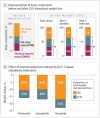Eddy Edson
Well-Known Member
- Relationship to Diabetes
- Type 2
Apparently not.

 jamanetwork.com
jamanetwork.com
The marked weight loss induced by GLP-1–based antiobesity medications and the results from several trials that found 25% to 40% of the weight lost was composed of FFM/lean body mass (Figure, B) have led to concerns regarding adverse effects of GLP-1–based antiobesity medications on physical function and possible treatment-induced physical “frailty.” However, none of these studies reported the effects of weight loss on SMM or objective measures of physical function. It is unlikely that the decline in SMM that occurs with even large amounts of weight loss impairs physical function. People with obesity generally have greater amounts of FFM and SMM than lean people,3 so the decrease in SMM induced by weight loss represents a small fraction of total body SMM. Moreover, even though the decrease in SMM can sometimes cause a decrease in muscle strength, it does not necessarily have an adverse effect on physical function. Intentional weight loss causes a greater relative decrease in body fat than FFM or SMM, so the ratio of FFM/SMM to fat mass increases. Accordingly, physical function and mobility improve after weight loss despite the decrease in FFM/SMM, even in older adults with decreased FFM and SMM at baseline. In addition, weight loss improves the “quality” of remaining muscle by decreasing intramyocellular and intermuscular triglycerides and increasing muscle insulin sensitivity.


Is Weight Loss–Induced Muscle Mass Loss Clinically Relevant?
This Viewpoint explores the effects of weight loss achieved through GLP-1–based antiobesity medications on weight regain, fat-free mass, and skeletal muscle mass in people with obesity.
The marked weight loss induced by GLP-1–based antiobesity medications and the results from several trials that found 25% to 40% of the weight lost was composed of FFM/lean body mass (Figure, B) have led to concerns regarding adverse effects of GLP-1–based antiobesity medications on physical function and possible treatment-induced physical “frailty.” However, none of these studies reported the effects of weight loss on SMM or objective measures of physical function. It is unlikely that the decline in SMM that occurs with even large amounts of weight loss impairs physical function. People with obesity generally have greater amounts of FFM and SMM than lean people,3 so the decrease in SMM induced by weight loss represents a small fraction of total body SMM. Moreover, even though the decrease in SMM can sometimes cause a decrease in muscle strength, it does not necessarily have an adverse effect on physical function. Intentional weight loss causes a greater relative decrease in body fat than FFM or SMM, so the ratio of FFM/SMM to fat mass increases. Accordingly, physical function and mobility improve after weight loss despite the decrease in FFM/SMM, even in older adults with decreased FFM and SMM at baseline. In addition, weight loss improves the “quality” of remaining muscle by decreasing intramyocellular and intermuscular triglycerides and increasing muscle insulin sensitivity.

